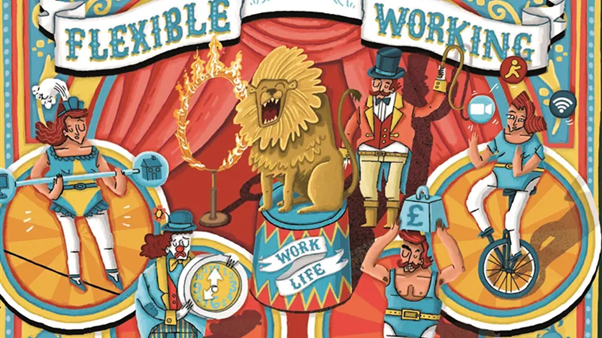A year on: Making ‘flexible working’ work

Hooray for new childcare arrangements from ages 1-2 announced in the budget – lets hope details are ironed out to really support parents and the sector.
It’s been almost a year back at work after maternity leave and as a working parent of pre-school children, I’ve had the ‘luxury’ of childcare being tailored around my work needs, typically 9-5 office/work-from-home hours. I now approach the school years of 9-3pm days and I’m exploring the options of flexible working my company offers and how to balance time, money and a fulfilling career – it can feel like a tough balancing act!
Of course, I spoke to numerous working parents in my network (thank you WUN!) I realised I had a very simplistic view of flexible working – there is far more than just 3/4/5 day weeks.
Hybrid working is now pretty much a given – a blend of working from home and in the office. For me at EDF, we have 1 day a week in a physical office with the team and 1 day a month where pretty much everyone in the division is in for social at lunch time to mix up the teams.
Full time but not 9-5 5 days a week.
A bit has changed since Dolly Parton sang 9-5 in the 80s. There are plenty of flexible sets up for a whole host of reasons, pursuing music/other careers outside of their corporate role, supporting charities and other options like compressed hours, i.e. Full time in 4 days or 9-day fortnights and job-sharing were also mentioned to make work work around the life people want to lead.
A 9-day fortnight is the pattern I use whilst my children are in nursery, but I’m finding it increasingly challenging to get the childcare arrangements in place and the running conversation on whether I’m working that Friday or not despite transparency on my calendar can wear a little bit thin. Not surprising then that Compressed hours are one of the least popular patterns!
See below for the link to -UK flexible working contracts by type 2022 | Statista
4-day work pattern
With Flexible working, I’m considering a 4 day week, with my research talking to fellow parents and the obligatory google, we concluded that ‘Wednesday’ is the ideal day to break up the week especially for long commutes and not miss out on bank holidays. Mondays off helped set up the week at home, but it’s a steep ramp up to ‘catch up’ on Tuesday and having Fridays off which seems to be popular, meant a tougher balancing act across teams with several 4-day work patterns and tighter end-of-week deadlines.
Whilst only ‘missing out’ on 1 day which ticked my career boxes of being in the loop, what a 4-day work pattern didn’t give was more than 1 school drop-off and pick up. There are more options but many company policies and indeed HR don’t give ‘blueprints’ of what works, but say it’s completely flexible – with so many options, I wanted more inspiration.
80% Contract – Flexitime
Through the WUN network and Working Parents and Women’s network at EDF, I spoke to several senior women and a few men about flexible working and being able to ‘step up’ AND balance family and home life. They all confirmed that a 4 day work pattern is great if you’re good at protecting the day, but for them something that worked better was a Flexi-time 80% contract – allowing you to choose, within certain set limits, when to begin and end work. It allowed more flex for 2-3 picks ups if working from home where the work schedule was quieter. It allowed for the occasional meeting on the ’official’ day off, but its your choice on how valuable it is to your career and is a more considered approach to your calendar. They did all caution that it was harder to switch off, but no format is perfect, it just needs to work.
Final Thoughts
I like to think I’m pretty observant, but what the exploration process has really highlighted is just how common place flexible working is, and how different it can be for so many people. My main take-away (which soothes one of my biggest worries), is that flexible working doesn’t necessarily change people’s perspectives on you – you can still be effective and reliable without a classic 9-5, 5 day a week set up, and as many people have proven, you can still succeed in getting promotions and getting interesting projects – I just never noticed until I started asking – and that’s the beauty of it!
There is more decision-making in a flexible set up, but we have choice and as mentioned in many of our WUN events, women bring so much to the table. We may choose to be part-time in one phase of our life, but the time we spend showing up, speaking up and taking part, is incredibly valuable in bringing diversity of thought, sparking new ideas from different perspectives for a better outcome.
We’d love to hear your thoughts on what working patterns you’ve designed or seen at work.
Lillian Philip- WUN advocate & Senior Manager, EDF.